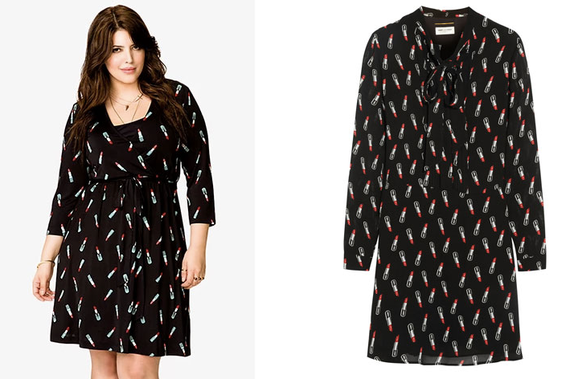Saint Laurent, under the creative direction of Hedi Slimane has just been accused of copying the fast fashion retailer forever21, highlighting a burgeoning problem in the business of fashion that creative directors are far more removed from the creative process than we think.
High-street brands like Forever 21 are accustomed to finding themselves associated with copying, but now the shoe is on the other foot and high fashion is getting its ideas from the high street, after fashion blogger and Marie Claire contributing editor Nicolette Mason noticed a lipstick print dress in the Saint Laurent's Fall/Winter 2015 collection almost identical to a dress from Forever21, the first to sell the lipstick dress design a few years back. With the business model of luxury brands being one that is customarily focused on 'exclusivity,' it seems surprising that a luxury fashion house would pinch from a fast fashion giant, and what's even more shocking is the price for which the luxury brand is selling the almost identical dress, $3,500 when the original dress cost a meagre $23.

FOREVER 21 (RIGHT) SAINT LAURENT, Net-a-porter.com (LEFT)
For Saint Laurent, in the three years since the creative director Hedi Slimane has joined the brand, it has more than doubled its revenue in sales, but with the creative director Jeremy Scott for the Italian fashion house Moschino a few months back being hit with his second lawsuit for copyright infringement, this time for copying the graffiti street artist Joseph Tierney and now Saint Laurent being accused of copying the retailer forever21, herein lies the issue, is commercial single-mindedness impacting luxury design houses creativity?
These infringement cases highlight a growing problem with luxury fashion brands these days, which begs the question, just how involved are creative directors in the creative design process? At one stage, the legitimacy of luxury was marked by traditional qualities of rarity and artistic craftsmanship, now it seems to depend on the legitimacy of a creative director and marketing of ever increasing products to a wider public. What's interesting here is that these cases draw our attention to the changing role of the creative director, which Nicolas Ghesquière spoke about in an interview with system magazine after his sudden departure from Balenciaga where he criticised the fashion house, (and was later sued for breach of confidentiality) revealing that he decided to leave the fashion house after 15 years because it" "became more corporate, until it was no longer even linked to fashion."
He put forward that." Everything became an asset for the brand, trying to make it ever more corporate - it was all about branding." He says "I began to feel as though I was being sucked dry, like they wanted to steal my identity while trying to homogenise things."
Particularly illuminating in that interview were his feelings about the changing culture of managing a fashion brand, he says: "It was really that lack of culture which bothered me in the end. The strongest pieces that we made for the catwalk got ignored by the business people." He says that "I started to become unhappy when I realised that there was no esteem, interest, or recognition for the research that I'd done; they only cared about what the merchandisable result would look like. This accelerated desire meant they ignored the fact that all the pieces that remain the most popular today are from collections we made ten years ago. They have become classics and will carry on being so." And in his role as creative director he laments "I was switching between the designs for the catwalk and the merchandisable pieces - I became Mr Merchandiser."
Are creative directors now just commodities? For luxury companies the identity of the owner or creative director of the company is critical in the success and creation of the brand's image. In the French philosopher, Bourdieu's analysis of the field of high fashion, he describes how fashion is an expression of the legitimate taste of the ruling class. According to his theory, those in a dominant position in the field of fashion are the designers 'who possess in the highest degree the power to define objects as rare by means of their signature, their label, those who label has the highest price'. In other words he argues that it is the unique position of a designer and the position he or she occupies within the field of fashion that consequently determines the value he or she is able to put on a product.
Bourdieu's critique attempts to explain the way the business of fashion works, and how a replica of a high street dress for $23, can later find itself sold under the guise of a high-end fashion house's label for more than one hundred times the original price. But the art of a good creative director is innovating, and yet the remit of a creative director is changing, it's no longer just about designing products. These cases then are not only examples of intellectual property infringement, but signal a 'cultural turn' in brand management and expose less talked about issues to do with a deterioration of creativity for the sake of an increase in commercial sales.
Tania Phipps-Rufus is the Founder and Editor-in-chief of the blog Fashion Law & Business. Tania is a lecturer & consultant at Istituto Marangoni, and teaches on the MA in Strategic Luxury Fashion Brand Management and the MA in Fashion Promotion, her scholarship focuses on the legal aspects of fashion business, and she is also a PhD candidate studying for her PhD on Fashion & Intellectual Property in the Creative Economy, at the University of Bristol.